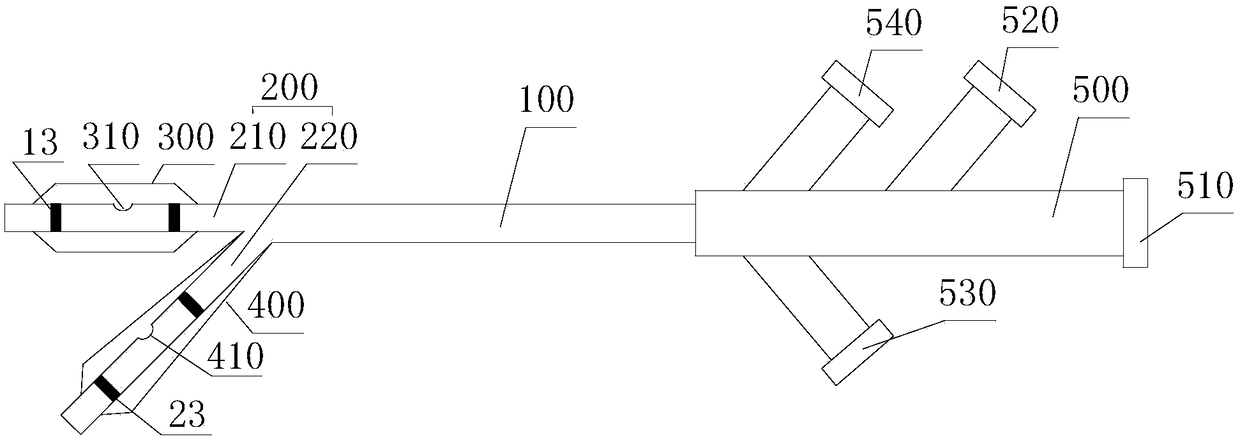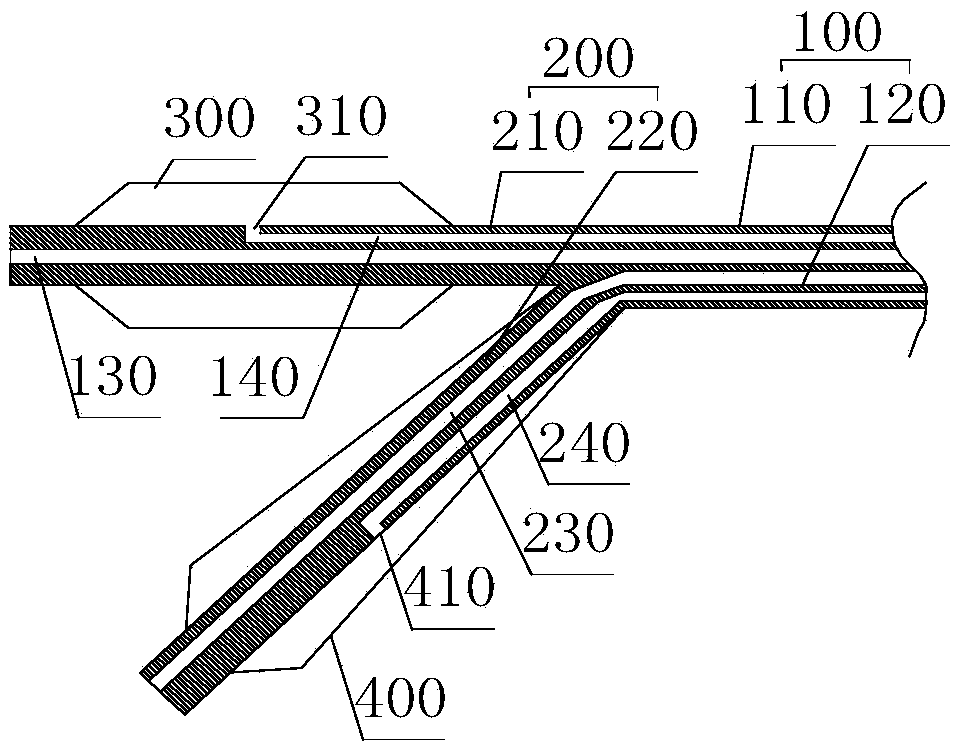Balloon catheter
A balloon catheter and balloon technology, applied in catheters, balloon catheters, dilators, etc., can solve problems such as increased pain, incomplete dilation of bifurcations, vascular dissection, etc., to avoid pain, reduce surgical complexity, and save surgery. effect of time
- Summary
- Abstract
- Description
- Claims
- Application Information
AI Technical Summary
Problems solved by technology
Method used
Image
Examples
Embodiment 1
[0029] See figure 1 , the balloon catheter provided by Embodiment 1 of the present invention includes a push catheter and at least two expandable balloons located at the distal end of the push catheter.
[0030] The pushing catheter includes a catheter body 100 and a branch body 200 disposed at the distal end of the catheter body 100 . The branch pipe body 200 includes at least two branches. Specifically, in this embodiment, the branch pipe body 200 has a Y-shaped structure, and has a first branch 210 and a second branch 220 respectively extending in different directions. The expandable balloon includes at least one first balloon 300 disposed at the distal end of the first branch 210 and at least one second balloon 400 disposed at the distal end of the second branch 220 . Specifically, in this embodiment, a first balloon 300 is provided at the distal end of the first branch 210 , and a second balloon 400 is provided at the distal end of the second branch 220 . In this way, ...
Embodiment 2
[0051] The structure of the balloon catheter provided in the second embodiment is basically the same as the structure of the balloon catheter provided in the first embodiment. The difference is that, in the balloon catheter provided in the second embodiment, the structure of the catheter body is different from that of the balloon catheter in the first embodiment.
[0052]Specifically, in this embodiment, the catheter body includes an outer tube (ie, the first tube body) and at least one inner tube (ie, the second tube body) worn in the outer tube. The first pipe body and the second pipe body are fixedly connected together and cannot move relative to each other. The distal end of the inner tube or the outer tube is respectively connected to the proximal end of the first branch or the proximal end of the second branch. The outer tube or / and the inner tube are provided with a first guide wire cavity, a second guide wire cavity, a first filling cavity and a second filling cavity ...
Embodiment 3
[0062] The structure of the balloon catheter provided in the third embodiment is basically the same as the structure of the balloon catheter provided in the first embodiment. The difference is that in the balloon catheter provided in the third embodiment, the structure of the catheter body is different from that of the balloon catheter in the first embodiment.
[0063] Specifically, see Figure 11 , the catheter body 100 of the pushing catheter includes a first tube body 110 and a second tube body 120 . The first tube body 110 and the second tube body 120 can move relative to each other along the axial direction. The distal end of the first tube body 110 is connected to the proximal end of the first branch 210 . The distal end of the second tube body 120 is connected to the proximal end of the second branch 220 . Thus, the first branch 210 and the second branch 220 in the branch pipe body 200 can move axially and radially at the same time. That is, the position between the...
PUM
 Login to View More
Login to View More Abstract
Description
Claims
Application Information
 Login to View More
Login to View More - R&D
- Intellectual Property
- Life Sciences
- Materials
- Tech Scout
- Unparalleled Data Quality
- Higher Quality Content
- 60% Fewer Hallucinations
Browse by: Latest US Patents, China's latest patents, Technical Efficacy Thesaurus, Application Domain, Technology Topic, Popular Technical Reports.
© 2025 PatSnap. All rights reserved.Legal|Privacy policy|Modern Slavery Act Transparency Statement|Sitemap|About US| Contact US: help@patsnap.com



